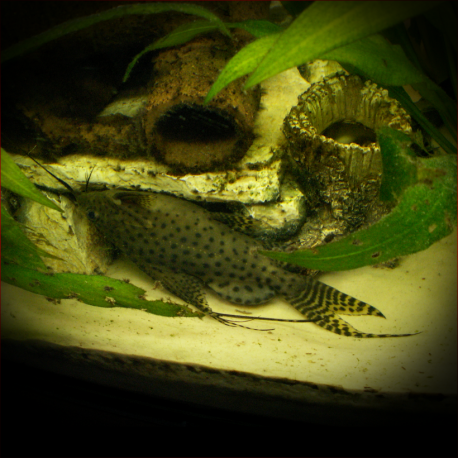More info
Datasheet
| Minimum Tank Size | 110 litres / 29.06 US gallons |
| Maximum Size | 30.0cm / 11.81inches |
| Temperature | 22°C / 71.60°F - 27°C / 80.60°F |
| Hardness | 8-20ºdH |
| pH | 6.0-7.5 |
General Description
Synodontis Euptera, commonly known as the Featherfin Synodontis or Featherfin Squeaker, is a popular species in the aquarium hobby. It features a reticulated patterning as juveniles which transforms into a simple spotted coloration in adulthood. Recognizable by its characteristic 'feathered' dorsal fin, this species can grow up to 30.0cm in length and has a lifespan of over 15 years when cared for properly. Found in Nigeria, Cameroon, Mali, Ghana, Sudan, Chad, and Niger, it adapts to varying biotopes in the wild.
Aquarium Setup
For housing Synodontis Euptera, a tank with a minimum capacity of 110 liters is recommended. Setting up the aquarium with a soft substrate, rocks, driftwood, twisted roots for hiding spots, and floating vegetation to reduce light intensity is ideal. While additional plants are beneficial, they are not mandatory for their habitat.
Behaviour
Featherfin Synodontis tends to become slightly territorial as it matures, especially towards other members of the Synodontis genus. It can be maintained in a small group in a suitably sized aquarium if each fish is provided with a refuge. It is advised not to keep them with fish small enough to be considered prey due to their adult size. Suitable tankmates include Alestiid tetras, robust cichlids, Mormyrids, Knifefish, Gouramis, and larger rasboras and barbs.
Feeding and Diet
Synodontis Euptera is an omnivorous species that accepts a wide range of foods including frozen, live, and dried options. They also enjoy vegetable matter such as shelled peas and cucumbers which they rasp at with their lower jaw teeth. They are not fussy eaters and can thrive on various diets in captivity.
Reproduction & Dimorphism
In aquaria, breeding of Synodontis Euptera is usually not achieved naturally, but commercial breeding has occurred with the aid of hormone injections. The species are egg scatterers and exhibit no parental care. Sexual dimorphism is noticeable in adult females being plumper than males. Sexing can be done by examining the genital papillae, but it requires expertise to distinguish between the genders accurately.
Habitat and Distribution
This species is naturally found in Nigeria, Cameroon, Mali, Ghana, Sudan, Chad, and Niger across various biotopes. It thrives in areas with seasonal flooding that are rich in micro-organisms, highlighting its adaptability to diverse aquatic environments.

